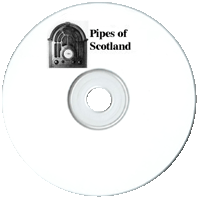

Elements which make the music of the bagpipes unique include the drones; pipes which are not fingered but whose reeds are tuned to harmonize with the melody pipe or chanter.

4 old time radio show recordings
(total playtime 43 min)
available in the following formats:
1 MP3 CD
or
1 Audio CDs
Text on OTRCAT.com ©2001-2025 OTRCAT INC All Rights Reserved. Reproduction is prohibited.

The funereal association of piping is a direct contrast to their original function, which was to provide dance music for pastoral celebrations. One of the distinguishing features of bagpipes is of course the bag, which is typically made from a whole animal skin. The reeds of the bagpipes are held within the wooden stocks which are tied into the holes in the skin, rendering it airtight.
Elements which make the music of the bagpipes unique include the drones; pipes which are not fingered but whose reeds are tuned to harmonize with the melody pipe or chanter. Since the reeds of the bagpipes, including that in the chanter, are sounded by the constant airflow from the bag (which the player inflates via a blow tube), there is no practical way to break the sound between the notes. Thus, the music is constant with flourishes between the movements.
The pipes seemed doomed to obscurity as other instruments came along which were as portable but had greater versatility. However, the British discovered that regiments raised in the Scottish Highlands were particularly effective in expanding and defending the Empire. Each regiment’s pipers would play a distinctive tune so that the soldiers could find and stay with their units during the confusion of battle. Great numbers of pipers were trained for service in the First and Second World Wars, and pipers are still a part of most units from the Commonwealth Nations. Pipers were used in the assault on enemy lines in the Second Battle of El Alamein in 1943.
Text on OTRCAT.com ©2001-2025 OTRCAT INC All Rights Reserved. Reproduction is prohibited.
You have reached the maximum number of votes for a unregistered user.
Please login or create a new account to continue...
You have reached the maximum number to down votes in this page.



Pipes of Scotland Disc A001
|
Add Audio CD to Cart - $5.00 |
Please wait...
COMMENTS
Be the first to comment on "Pipes of Scotland"
Leave a comment